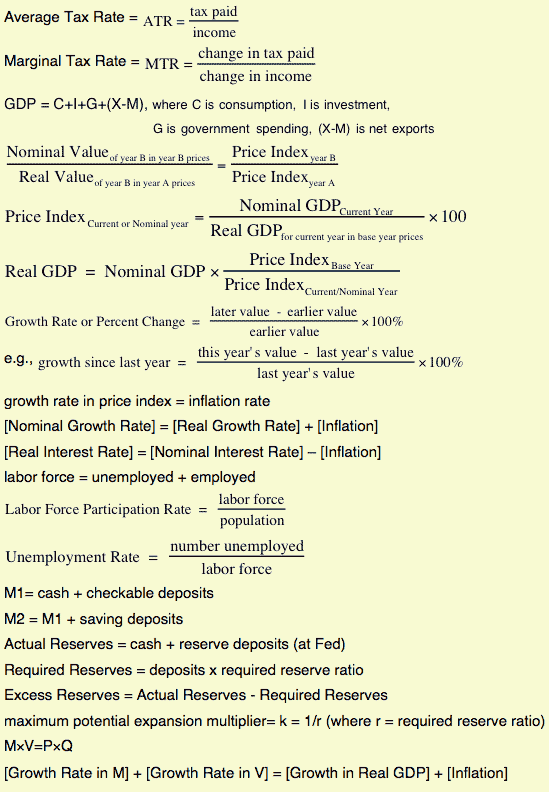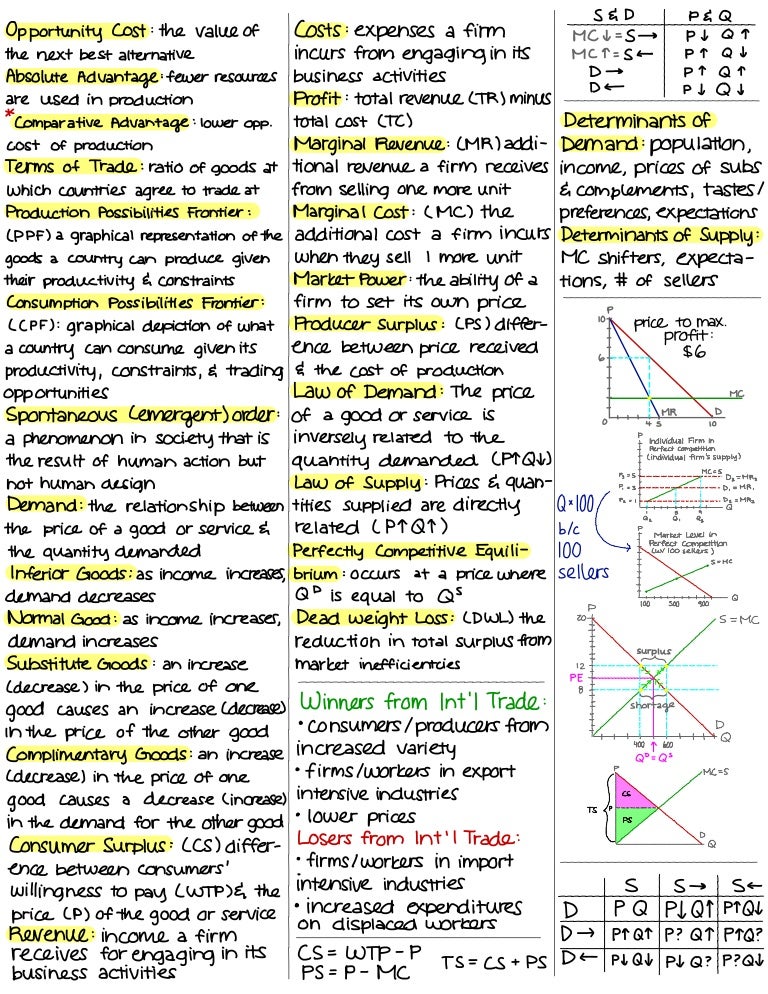Microeconomics Formulas Cheat Sheet
Microeconomics Formulas Cheat Sheet - Web formula sheet microeconomics allocative eficiency condition p = mc, or more precisely, marginal social benefit (msb) = marginal social cost (msc) average fixed cost total fixed cost (tfc) afc = quantity. Web law of demand: Capital supply and capital markets. Quantity demanded increases when prices decrease and vise versa. Microeconomics is the study of economics where the performance of firms and individuals towards delivering sustainable results by employing limited resources are. Web list of microeconomics formula. Web formulas utility maximizing rule: Lower price = higher income = higher demand.
Web formulas utility maximizing rule: Lower price = higher income = higher demand. Capital supply and capital markets. Quantity demanded increases when prices decrease and vise versa. Web formula sheet microeconomics allocative eficiency condition p = mc, or more precisely, marginal social benefit (msb) = marginal social cost (msc) average fixed cost total fixed cost (tfc) afc = quantity. Web law of demand: Microeconomics is the study of economics where the performance of firms and individuals towards delivering sustainable results by employing limited resources are. Web list of microeconomics formula.
Microeconomics is the study of economics where the performance of firms and individuals towards delivering sustainable results by employing limited resources are. Web formula sheet microeconomics allocative eficiency condition p = mc, or more precisely, marginal social benefit (msb) = marginal social cost (msc) average fixed cost total fixed cost (tfc) afc = quantity. Web law of demand: Capital supply and capital markets. Web list of microeconomics formula. Quantity demanded increases when prices decrease and vise versa. Web formulas utility maximizing rule: Lower price = higher income = higher demand.
Key Formula Sheet for Macroeconomics
Quantity demanded increases when prices decrease and vise versa. Lower price = higher income = higher demand. Web list of microeconomics formula. Capital supply and capital markets. Web law of demand:
Pin on Educational
Web law of demand: Quantity demanded increases when prices decrease and vise versa. Capital supply and capital markets. Web formulas utility maximizing rule: Lower price = higher income = higher demand.
Formula Sheet for microeconomics to calculate problems. ECON 250
Lower price = higher income = higher demand. Capital supply and capital markets. Quantity demanded increases when prices decrease and vise versa. Microeconomics is the study of economics where the performance of firms and individuals towards delivering sustainable results by employing limited resources are. Web list of microeconomics formula.
Key Formula Sheet for Microeconomics Economics notes, Economics
Web list of microeconomics formula. Web formulas utility maximizing rule: Web law of demand: Lower price = higher income = higher demand. Quantity demanded increases when prices decrease and vise versa.
Microeconomics Cheat Sheet PDF PDF
Web formula sheet microeconomics allocative eficiency condition p = mc, or more precisely, marginal social benefit (msb) = marginal social cost (msc) average fixed cost total fixed cost (tfc) afc = quantity. Quantity demanded increases when prices decrease and vise versa. Web law of demand: Lower price = higher income = higher demand. Web list of microeconomics formula.
Principles of Microeconomics Notes
Capital supply and capital markets. Lower price = higher income = higher demand. Quantity demanded increases when prices decrease and vise versa. Microeconomics is the study of economics where the performance of firms and individuals towards delivering sustainable results by employing limited resources are. Web formulas utility maximizing rule:
Formula sheet final ECO 3101 Formula sheet Q p b Q p p Q p p Q Q p Q
Capital supply and capital markets. Web law of demand: Web formula sheet microeconomics allocative eficiency condition p = mc, or more precisely, marginal social benefit (msb) = marginal social cost (msc) average fixed cost total fixed cost (tfc) afc = quantity. Lower price = higher income = higher demand. Microeconomics is the study of economics where the performance of firms.
Principles of Microeconomics Midterm 2 "Cheat Sheet" Economics
Capital supply and capital markets. Web law of demand: Microeconomics is the study of economics where the performance of firms and individuals towards delivering sustainable results by employing limited resources are. Web formula sheet microeconomics allocative eficiency condition p = mc, or more precisely, marginal social benefit (msb) = marginal social cost (msc) average fixed cost total fixed cost (tfc).
economics cheat sheet Microeconomics Ultimate Cheat Sheet Formulas
Microeconomics is the study of economics where the performance of firms and individuals towards delivering sustainable results by employing limited resources are. Lower price = higher income = higher demand. Web law of demand: Web formula sheet microeconomics allocative eficiency condition p = mc, or more precisely, marginal social benefit (msb) = marginal social cost (msc) average fixed cost total.
Microeconomics Cheat Sheet 1
Web list of microeconomics formula. Web formulas utility maximizing rule: Web law of demand: Microeconomics is the study of economics where the performance of firms and individuals towards delivering sustainable results by employing limited resources are. Quantity demanded increases when prices decrease and vise versa.
Lower Price = Higher Income = Higher Demand.
Web law of demand: Web list of microeconomics formula. Capital supply and capital markets. Web formula sheet microeconomics allocative eficiency condition p = mc, or more precisely, marginal social benefit (msb) = marginal social cost (msc) average fixed cost total fixed cost (tfc) afc = quantity.
Web Formulas Utility Maximizing Rule:
Microeconomics is the study of economics where the performance of firms and individuals towards delivering sustainable results by employing limited resources are. Quantity demanded increases when prices decrease and vise versa.









